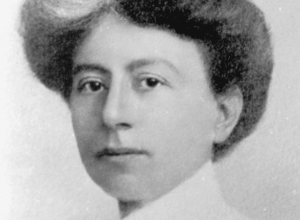Margaret Floy Washburn: The First Woman Psychologist

Margaret Floy Washburn was a brilliant student who was ahead of her time. Her character and tenacity gained her the respect of many of her fellow psychologists. Since colleges didn’t accept women during her time, she was only accepted as a “listener”. However, despite all of this, we’ll always remember her as the first woman to get a Ph.D. in psychology.
Whenever we think of psychology pioneers, important names such as Sigmund Freud, Piaget, and Jung come to mind. Yes, they were really important contributors. However, many women who were also psychology pioneers have remained in the background, eclipsed by the men of their time.
Margaret Floy Washburn and Prejudice
The general public has many prejudices about the most outstanding psychology figures. We simply aren’t aware of women’s role in many areas. They were even the pioneers in many fields. Their stories and discoveries have often been blurred or overshadowed by the male figures of their times. Due to that, it’s difficult to retrieve them from the shadows of history.
Psychology, just like other disciplines, has relied on women who have made significant contributions to its development. However, they nearly always had to overcome great obstacles in order to be recognized by their peers.
Far from helping them, what they actually did was try and demonstrate women’s physical, moral, and social incapacity to be able to contribute any serious form of scientific knowledge.
A very clear example of this is Margaret F. Washburn. As we mentioned earlier, Columbia University wouldn’t admit her because she was a woman. She overcame tremendous obstacles in order to work as a psychologist within the academy. In addition to that, she was also excluded from different scientific societies, such as the “Experimentalists”, led by Edward B. Titchener.
Until well into the 20th century, universities denied entry to women. In addition to that, many professions that required any form of study or research wouldn’t accept them either. To all of this, we need to add cases of women whose stories and lives have been erased from history. And with them, all their research and discoveries.
“The history of men’s opposition to women’s emancipation is more interesting perhaps than the story of that emancipation itself.”
-Virginia Woolf-
A Story of Resilience
Margaret Floy Washburn was born in 1871 in New York. She was an only child. Her family moved regularly, as her father was a curate in the Anglican Church and he often had to move around to different parishes.
She was a brilliant student and decided to study psychology at Columbia University in New York. She chose this university because Professor James McKeen Cattell taught there. He was one of the most important psychologists of the late 19th and early 20th centuries.
As a representative of the so-called American School of Psychology, he helped to establish psychology as a “trustworthy” science. Until then, many had considered it a pseudoscience.
Despite its brilliant academic record, Columbia University didn’t admit female students. Because of that, Washburn could only attend as a “listener”. When Cattell observed his student’s interest, he encouraged her to apply to Cornell University where she was lucky enough to work under the tutelage of Titchener.
An Experimental Study
She carried out an experimental study of the methods of equivalence in tactile perception and obtained a Master’s degree for this work. She then developed her doctoral thesis on the influence of visual images on the judgments of tactile distance and direction.
Titchener sent this paper to Philosophische Studien, who published it in 1895. The year before, she became the first woman to receive a Ph.D. in Psychology.
In 1908, Margaret Floy Washburn published her most important and well-known book, The Animal Mind. This was a book of comparative psychology, where she compiled research on experimental work in animal psychology.
The text covered a wide range of activities related to the senses and perception. Washburn’s work was supported and recognized. She was apparently indifferent to the sexist discriminations against her.

Due to her conciliatory nature, she became one of the first two women to be admitted into the club of “experimentalists”. This happened after the death of Titchener, its founder, and after 25 years of excluding women.
Dr. Washburn’s life was, without a doubt, an exciting one. She fought to the end to achieve the goals she had set for herself. However, even though her colleagues recognized her merits, history hasn’t yet given her the relevance and social recognition she really deserves.
“Anyone who knows anything of history knows that great social changes are impossible without feminine upheaval. Social progress can be measured exactly by the social position of the fair sex, the ugly ones included.”
-Karl Marx-
This text is provided for informational purposes only and does not replace consultation with a professional. If in doubt, consult your specialist.








